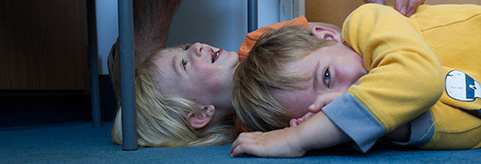Velopharyngeal Insufficiency
The UCSF Craniofacial Center specializes in the comprehensive evaluation, treatment, and ongoing care of patients diagnosed with Velopharyngeal (ve-lo-pha-ryn-ge-al) Dysfunction (VPD). Velopharyngeal dysfunction describes disorders of the velopharyngeal valve, including velopharyngeal insufficiency (VPI), velopharyngeal incompetence (VPI) and velopharyngeal mislearning. The craniofacial multidisciplinary team evaluates each patient’s speech sound production, oral and nasal resonance (sound energy traveling through the nose and mouth), velopharyngeal function (movement of the soft palate and related structures during speech), and genetic background.
A number of craniofacial conditions are commonly associated with velopharyngeal dysfunction, including:
- Cleft palate
- Submucous cleft palate or bifid uvula
- Palatopharyngeal disproportion (cervical anomalies, flattened cranial base)
- 22q11 deletion syndrome (velopcardiofacial (VCF)/DiGeorge syndrome
- Craniofacial microsomia (hemifacial microsomia/Goldenhar syndrome)
- Mechanical interference of tonsils, adenoid or posterior pillar web
- Hypernasal speech after primary or secondary palate repair or adenoidectomy
- Airway obstruction
- Ablative palatal lesions
- Cancer
- Traumatic injury
- Congenital motor/neuromotor control (i.e., dysarthria) or motor association/motor programming (i.e., apraxia) diseases
Patients may have difficulty being understood by others, or may report resonance (e.g., sounding nasal or hypernasal) or voice issues.
The common assessment protocol used to diagnose VPD is as follows:
- Speech Assessment
- Nasometric Assessment
- Oral exam
- Imaging
- Cephalometrics
- Nasopharyngosocpy (also called a nasoendoscopy)
- Genetic Assessment
Treatment should begin as soon as possible to promote good speech habits. As the young child develops speech, they develop lifelong speech habits. Normal speech/articulation habits might not develop if the child cannot achieve balanced resonance without hypernasality. The persistence of poor speech habits are often hard to change later.
The treatment of VPD depends on the type and cause of the problem. Velopharyngeal mislearning can only be treated by speech therapy. The treatment of velopharyngeal insufficiency or velopharyngeal incompetency usually requires surgery (tonsillectomy, palate lengthening by Furlow Z-plasty, posterior pharyngeal wall augmentation, pushback, sphincter pharyngoplasty, or pharyngeal flap. Prosthetic devices can also be used on a temporary or permanent basis in some cases.
Following surgical intervention, your child will require postoperative speech therapy for residual misarticulations and/or residual oral versus nasal speech learning. If your child requires post-surgical speech therapy, the craniofacial speech/language pathologist will advise your child’s local therapist on speech targets and effective treatment methods.
Individuals with velopharyngeal dysfunction benefit from coordinated care that brings together all of the related specialties that may be needed to manage both the physical and functional aspects of the condition.


